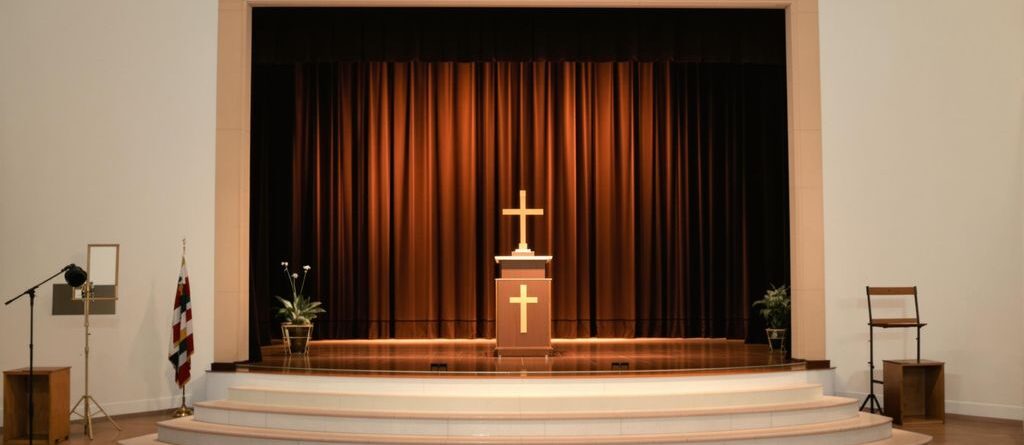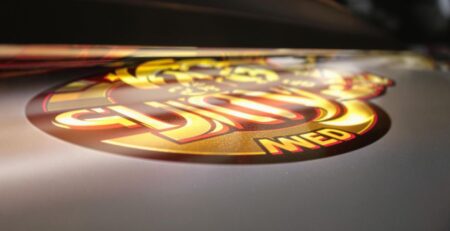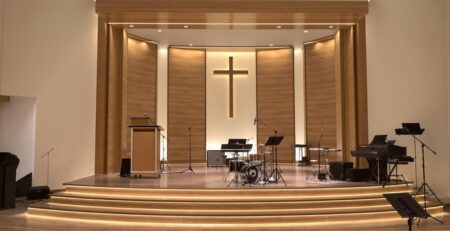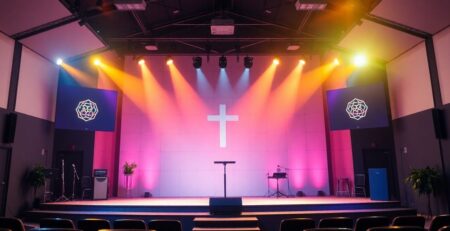Inspiring Small Church Stage Design Ideas for Your Sanctuary
Having a small church doesn’t mean your stage has to be boring or plain. Actually, it’s a chance to get super creative! With some smart thinking and a few simple tricks, you can make your sanctuary feel really special and inviting. We’re talking about making the most of what you’ve got, whether it’s using lights, rearranging things, or even just adding some plants. These small church stage design ideas can totally change the vibe of your space without breaking the bank. Let’s look at some easy ways to make your stage pop and help everyone feel more connected.
Key Takeaways
- Using vertical space can make a small stage look much bigger.
- Simple lighting changes can totally transform the mood of your sanctuary.
- You don’t need a huge budget; DIY backdrops and repurposed items work great.
- Thinking about themes for holidays or sermon series adds a nice touch.
- Making stage elements easy to move helps with quick changes and storage.
Maximizing Small Spaces with Creative Stage Layouts

Utilizing Vertical Space for Visual Impact
Small church stages often feel cramped, but thinking vertically can dramatically expand perceived space. Consider tall, slender banners or lightweight, multi-tiered shelving to draw the eye upward. This not only adds visual interest but also keeps the floor area clear, making the stage feel less cluttered. How can you use height to create a more spacious feel?
Flexible Seating Arrangements for Intimacy
Fixed seating can limit the versatility of a small sanctuary, so explore flexible seating options to maximize intimacy. Modular chairs or even comfortable floor cushions can be easily rearranged for different services or events. This adaptability allows you to create a more intimate atmosphere for smaller gatherings while still accommodating larger crowds when needed. What seating arrangements best suit your church’s needs?
Multi-Purpose Platforms for Dynamic Use
Investing in multi-purpose platforms is a game-changer for small church stages, and these platforms can serve as risers for the choir, a stage for dramas, or even a temporary altar. Choose lightweight, modular platforms that can be easily moved and reconfigured to suit different needs. This adaptability ensures that your stage is always ready for whatever event you have planned. Are you ready to unlock the potential of your stage with multi-purpose platforms? Consider transforming church interiors to maximize space and functionality.
Budget-Friendly Decor for Inspiring Atmospheres
DIY Backdrops with Fabric and Lighting
Transform your stage with DIY backdrops using affordable fabrics and creative lighting techniques. Simple fabric drapes, when paired with strategically placed lights, can create stunning visual effects. Consider using inexpensive materials like muslin or burlap, and experiment with different colors and textures to achieve the desired mood. This approach saves money and allows for easy customization, making your stage a captivating space for worship.
Repurposing Everyday Items for Stage Elements
Think outside the box and repurpose everyday items to create unique stage elements. Old wooden pallets can be transformed into rustic platforms, while mason jars can serve as charming candle holders. By creatively reusing items you already have or can find at thrift stores, you can add character and visual interest to your stage without breaking the bank. What unexpected items can you reimagine for your sanctuary?
Strategic Use of Plants and Natural Elements
Bring the beauty of the outdoors inside by incorporating plants and natural elements into your stage design. Potted plants, branches, and stones can add texture, color, and a sense of tranquility to your worship space. Opt for low-maintenance plants that are easy to care for, and arrange them strategically to create visual focal points. Using plants and natural elements is an affordable way to create a welcoming and inspiring atmosphere, and you can even use custom outdoor banners to promote your church’s events.
Innovative Lighting Techniques for Enhanced Worship
Accent Lighting to Highlight Key Areas
Accent lighting can dramatically improve your church’s stage presence. Strategic use of spotlights and focused beams draws attention to specific elements like the pulpit, the worship team, or any visual focal points. This technique not only guides the congregation’s eyes but also adds depth and dimension to the stage, creating a more engaging and visually appealing worship experience.
Color Washes for Mood and Emotion
Color washes are an easy way to transform the atmosphere of your sanctuary. By bathing the stage in different colors, you can evoke specific emotions and enhance the message of the service. For example, blues and purples can create a sense of reverence and peace, while warmer tones like oranges and yellows can bring energy and excitement. Experiment with different color combinations to find what best complements your worship style and sermon themes, making each service a unique and immersive experience.
Simple LED Solutions for Versatility
LED lighting offers a cost-effective and versatile solution for small church stages. LEDs are energy-efficient, long-lasting, and come in a wide range of colors and styles. You can easily control the intensity and color of LED lights to create different moods and effects, making them perfect for various worship styles and events. Consider investing in LED strip lights, spotlights, or par cans to add depth and visual interest to your stage, and don’t forget to check out step and repeat backdrop banner options to enhance the overall aesthetic.
Transforming Your Sanctuary with Thematic Designs

Thematic designs can breathe new life into your sanctuary, creating engaging and memorable experiences for your congregation. By carefully considering the message you want to convey, you can transform your stage into a powerful visual tool. How can you use themes to deepen the impact of your services?
Seasonal Stage Setups for Special Events
Seasonal stage setups are a fantastic way to celebrate holidays and special events, making your sanctuary feel festive and relevant. Consider using colors, props, and backdrops that reflect the season, such as pumpkins and fall foliage for autumn or bright colors and floral arrangements for spring. What simple changes can you make to reflect the changing seasons and engage your congregation?
Story-Driven Visuals for Sermon Series
Story-driven visuals can significantly enhance your sermon series, helping to illustrate key points and engage your audience on a deeper level. Think about using backdrops, props, and lighting to create a visual representation of the story you’re telling. How can you use visual storytelling to make your sermons more memorable and impactful? Consider using ProPresenter’s Stage Layout Editor to help you plan your visuals.
Creating a Consistent Aesthetic for Your small church stage design ideas
Developing a consistent aesthetic for your stage design creates a sense of unity and professionalism, reinforcing your church’s brand and message. Choose a color palette, font, and style that reflects your church’s values and use them consistently across all your stage elements. What simple design choices can you make to create a cohesive and visually appealing environment?
Practical Solutions for Portable Stage Elements
Modular Components for Easy Setup and Storage
Portable stage elements are a game-changer for small churches needing flexibility. Modular stage components offer the perfect solution for churches that need to quickly set up and tear down their stage. These systems are designed for easy assembly and disassembly, making them ideal for churches that share space or have limited storage. Think about how much easier it would be to transform your fellowship hall into a worship space each week with minimal effort. What if you could reconfigure your stage for different events without needing a dedicated crew?
Lightweight Materials for Mobility
Lightweight stage materials are essential for easy transport and handling. Choosing materials like aluminum framing and lightweight platforms makes a huge difference when moving and setting up your stage. This not only reduces strain on volunteers but also speeds up the setup process. Consider how much time and energy you could save by using small church stages for sale that are designed for portability. Could lighter materials make your stage setup less of a chore and more of a joy?
Designing for Quick Transitions Between Services
Efficient stage design allows for seamless transitions between different services or events. A well-thought-out portable stage design should enable quick changes in layout and setup. This might involve using reversible backdrops, easily movable props, or pre-set lighting configurations.
Imagine being able to switch from a traditional service to a contemporary worship experience in minutes. By planning for quick transitions, you can maximize the use of your space and cater to diverse audiences. How can you design your stage to be as adaptable as possible?
Integrating Technology Seamlessly into Stage Design
Discreet Placement of Screens and Projectors
Technology can greatly enhance a small church stage, but it’s important to keep it from being distracting. Strategically hiding screens and projectors ensures the focus remains on the service, not the tech. Consider recessed projector mounts or screens that retract when not in use to maintain a clean and reverent atmosphere.
Cable Management for a Clean Look
Messy cables can ruin the aesthetic of even the most well-designed stage. Effective cable management is crucial for a professional and safe environment. Use cable trays, ties, and concealed pathways to keep wires organized and out of sight, preventing tripping hazards and maintaining a visually appealing space.
Using Digital Backdrops for Dynamic Scenery
Digital backdrops offer incredible versatility for small church stages. Projecting images or videos onto a screen or wall allows you to change the scenery quickly and easily to match the theme of the service. This creates a dynamic and engaging worship experience without the need for bulky physical sets.
Enhancing Acoustics Through Thoughtful Design
Strategic Placement of Sound Panels
Effective church acoustics are vital for clear communication and immersive worship. Strategic placement of sound panels can significantly reduce unwanted reflections and reverberation, leading to improved speech intelligibility and a more pleasant listening experience. Consider placing panels on walls and ceilings, especially in areas where sound tends to bounce, like corners and behind the stage. This creates a more controlled sound environment, making it easier for your congregation to hear and understand the message.
Material Choices for Optimal Sound Reflection
Selecting the right materials plays a crucial role in shaping your church’s acoustics. Hard surfaces like concrete and tile reflect sound, while softer materials like fabric and carpet absorb it. Using a combination of both can help balance the sound, creating a more natural and engaging atmosphere. What materials will you choose to create the best sound for your space?
Minimizing Echo in Small Church Spaces
Echo can be a major problem in smaller church spaces, making it difficult to understand speech and appreciate music. Soundproofing a church is challenging, but minimizing echo is achievable through careful planning and design. Consider using acoustic treatments like bass traps and diffusers to break up sound waves and reduce reflections. By addressing echo issues, you can create a more comfortable and inviting space for worship.
Want to make your space sound better? Good design can really help! Learn how smart choices in building and decorating can make a big difference in how sound travels. Check out our website to see how we can help you make your rooms sound amazing.
Bringing Your Small Church Stage Ideas to Life
So, there you have it. Making your small church stage look good doesn’t have to be a huge headache or cost a ton of money. It’s really about being smart with what you have and thinking a bit outside the box. Even simple changes can make a big difference in how your sanctuary feels. Just remember, the goal is to create a space that helps everyone feel welcome and connected. With a little planning and some teamwork, you can totally transform your stage into something special. Give it a try!
Frequently Asked Questions
How can I make a small church stage look bigger?
You can make small spaces feel bigger by using tall decorations and clever lighting. Think about putting up things that draw your eyes upward, and use lights to make certain spots stand out.
Can I decorate my stage on a tight budget?
Yes, absolutely! You can use simple things like fabric, old furniture, or even plants to make your stage look great without spending a lot of money. Just be creative with what you have.
What’s the big deal about lighting for a church stage?
Good lighting can change the whole mood of your stage. Use different colors of light to create feelings, and shine brighter lights on important areas like where the speaker stands. Even simple LED lights can do a lot.
How do I pick a theme for my stage design?
Think about the time of year or what your sermon series is about. You can change your stage decorations to match holidays, seasons, or the stories you’re telling. This makes the stage feel fresh and connected to your message.
My church uses its space for many things. How can I make the stage easy to move?
Look for stage pieces that are light and can be taken apart easily. This way, you can move them around, store them when not needed, and quickly set them up or change them between services.
How do I add screens and tech to the stage without it looking messy?
You can hide screens and projectors so they don’t stick out too much. Also, make sure all the wires are neatly tucked away. Using digital backgrounds on screens can make your stage look different without needing lots of physical props.











